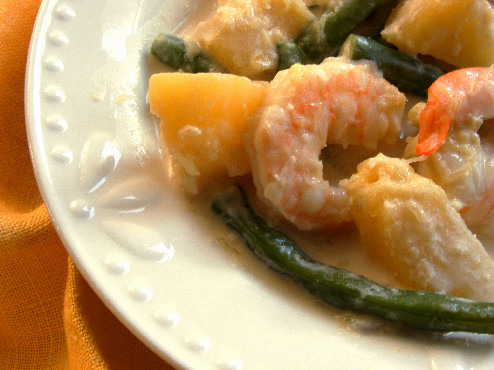Coconut Milk: Filipino Shrimp, Green Beans & Squash – Ginataang Sitaw Kalabasa
Wednesday, February 23rd, 2011Coconut milk is all that and then some. It is the perfect creamy addition for both sweet and savory dishes.
In our house, we use coconut milk more often with spicy curries and soups and only occasionally in drinks like coquito and sweets like Vietnamese rice pudding (che dau trang).
Growing up, coconut was rarely eaten in our house – except for the shredded version my mom used in desserts or those extremely rare occasions when my dad busted open a hairy, brown coconut. First, he carefully drained the precious coconut water by piercing the coconut eyes (pores) with a hammer and long nail. As youngsters, my little sister and I always lined up for a sip. Then he covered the coconut with a towel and whacked it with the hammer. And, finally we got to pry at that precious white flesh.
Fresh coconut is still hard to come by, and a bit hit or miss when I find one at the market here in Denver. Thankfully, canned coconut milk is more readily available.
In this Filipino recipe for Ginataang Sitaw Kalabasa, squash and green beans are simmered in coconut milk to create a luscious meal. “Ginataang” (also spelled “ginataan” or “guinataan”) is a Filipino term referring to food cooked with “gata,” the Tagalog word for coconut milk.
My girlfriend Cher turned me onto this dish last fall when her garden was bursting with buttercup squash and the cool weather of the new season was setting in. It’s one of her favorite Filipino dishes that her mamma makes. It’s so good that my husband and I gobbled up three servings each and took home the leftovers. I can be gluttunous – especially where coconut milk is involved.
If you can find buttercup squash use it – please. As the name suggests, it’s buttery and also a little sweet. Its flavor is not duplicated with other squash varieties. If you can’t find buttercup, substitute with acorn or your favorite squash – your dish will still be delicious. Also note that most traditional recipes for ginataang sitaw kalabasa use long beans, but tender green beans are a good substitute.
This is comfort food, Filipino style.
Tidbits on coconut milk:
- The coconut tree, cocos nucifer, is considered one of the most useful trees in the world. The long list of uses includes: food and drink, serving vessels, cooking fuel, textile fibers, thatching/basket materials, timber, medicines and many other useful products.
- Coconut milk is a thick sweet liquid that is made by pressing water through grated coconut flesh. Do not confuse coconut milk with the naturally occurring opaque liquid derived from the coconut.
- Canned coconut milk has a fat content ranging from 10 to 25 percent. The higher the percentage means it has more coconut cream and less water, and is also more thick. Pay attention to whether your recipes call for milk or cream.
- When purchasing coconut milk, opt for those canned versions that do not contain gums or thickeners. Quality canned coconut milk will separate, with the cream rising to the top. Just shake the can before using. Coconut milk is also available in fresh form in the refrigerated section of markets.
- Refrigerate unused canned coconut milk and use within a few days.







